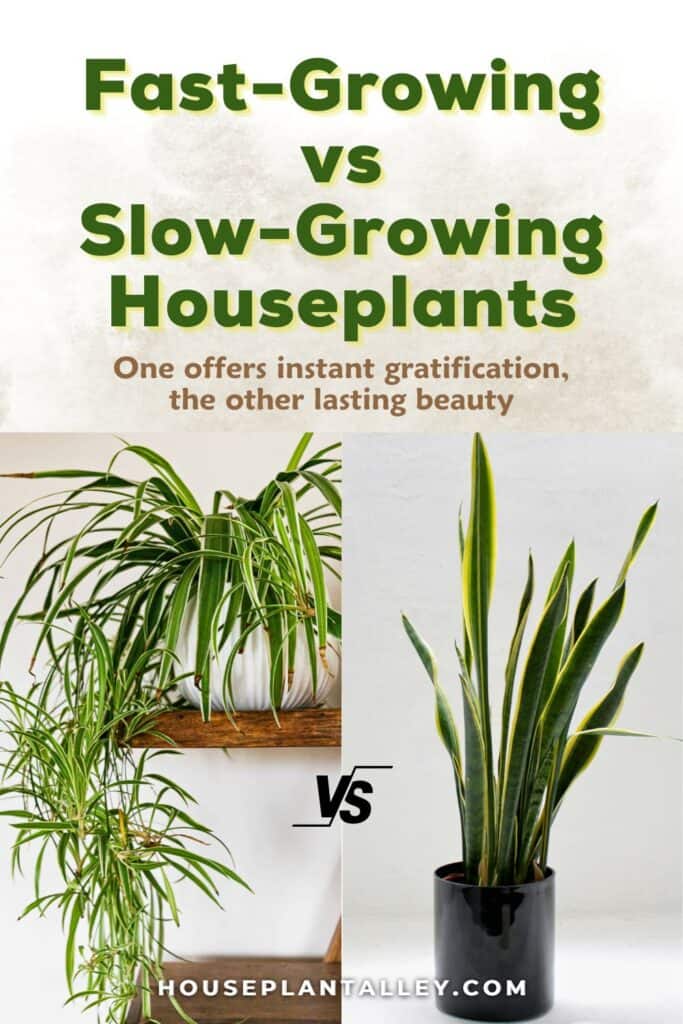Some houseplants shoot up fast, making your space feel full of life in just a few weeks. Others take their time, growing slowly month by month. Think of pothos, which can grow about a foot each month, compared to the snake plant that might only grow one or two leaves a year. Before you decide which kind is right for you, take a moment to think about your plant care style and how much space or patience you have.

Contents
🌱 What Makes Plants Grow Fast (or Slow)
A plant’s growth rate depends on how quickly its cells divide and stretch out. Fast-growing plants are like energetic sprinters—they grow quickly when they get the right care. Their cells multiply fast, especially with good light and water.
Pothos, spider plants, and philodendrons are great examples. When kept in bright but indirect light, with regular watering and fertilizer, they can grow several inches every month.
On the other hand, slow-growing plants are more like quiet thinkers. Snake plants and ZZ plants grow carefully, saving energy and building thick, strong leaves that can handle tougher conditions. These plants grow slowly, sometimes taking months before you see a new leaf.
🌿 Fast-Growing Houseplants That Show Quick Results
If you want plants that grow fast and make your space feel green in a hurry, here are some popular choices:
- Pothos and Philodendron: Grow up to 12–18 inches a month
- Spider Plant: Produces baby “spiders” and grows quickly in most homes
- Wandering Jew and String of Pearls: Grow 6–8 inches per month, especially in spots with good humidity and bright light
To keep them happy:
- Place them in bright, indirect light
- Keep temperatures between 65–80°F
- Water when the top of the soil feels dry
- Use balanced liquid fertilizer (like 10-10-10) once a month during the growing season
🐢 Slow-Growing Plants That Last for Years
Slow growers might not change much in a few weeks, but they add timeless beauty to your home. They’re great if you want plants that don’t need much care and stick around for years.
- ZZ Plant: Grows just a few inches a year but its glossy leaves are stunning and long-lasting
- Snake Plant: Adds 1–2 leaves per season, super easy to care for
- Cast Iron Plant: Tough and slow, but lasts over a decade
- Jade Plant and Sago Palm: Only grow about an inch a year, but become unique statement plants over time
These are perfect for people who love a steady, low-effort green vibe.
🔍 Fast vs. Slow Growth: What’s the Trade-Off?
Choosing between fast and slow growers depends on what kind of plant parent you are. Here’s what to expect:
| Growth Rate | Pros | Cons |
|---|---|---|
| Fast-Growing | Quick results, fun to watch | Need more trimming, frequent repotting |
| Slow-Growing | Easy care, long-lasting | Take time to show changes |
Fast plants usually need repotting every 6–12 months, while slow ones can stay in the same pot for 2–3 years. If you’re short on time or space, slow-growers might be easier to manage.
🌿 Mix and Match for the Best Plant Combo
A mix of fast and slow growers can make your indoor garden more exciting and easier to care for. Try using:
- 70% slow growers: They keep the look stable and low-maintenance
- 30% fast growers: They add energy and quick visual impact
Place your fast-growing plants near entryways or shelves where they can fill space quickly. Use slow-growing ones in corners or focal spots where their steady growth feels calming.
With the right combo, you’ll enjoy both instant greenery and long-term beauty.
